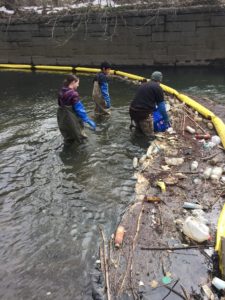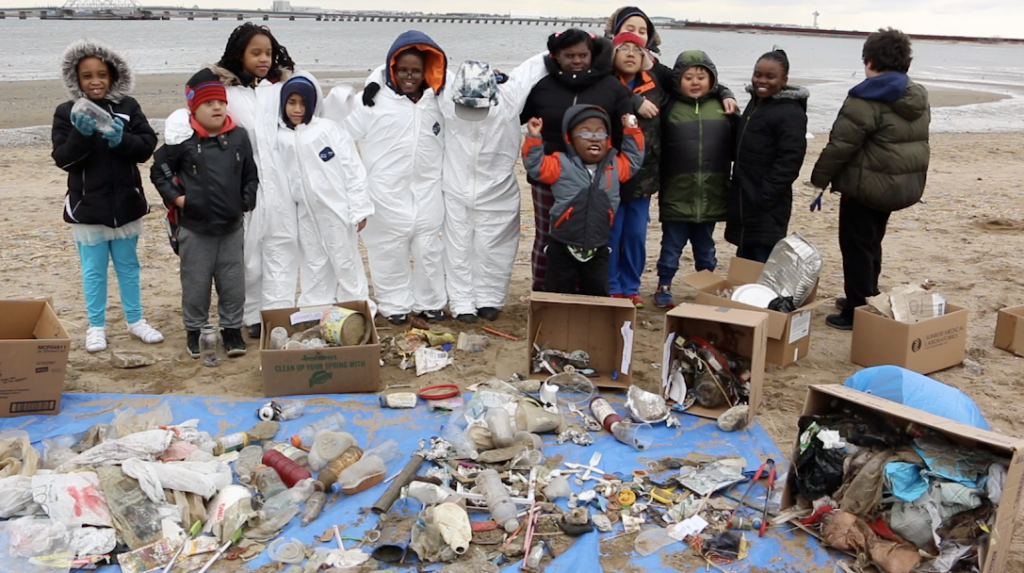This article was originally published in Interstate Waters in March 2019.

Public Participation Is Central to Curbing Aquatic Trash
At regular intervals in the summer of 2017, small teams of students, volunteers, and event coordinators donned hip boots and waded into the Bronx River at Muskrat Cove. Some wore tee shirts, broad-brimmed hats, or sunglasses. On those days, the groups splashed toward a bright yellow boom floating across the full width of the river to trap plastic bottles and bags, straws, polystyrene cups, cigarette butts, and more trash. The teams took the debris from the river and counted and categorized it, down to the last Styrofoam pellet and Dunkin Donuts cup. For nearly two years, such teams performed sixty-eight similar assessments throughout the spring, summer, and fall at Muskrat Cove and at other sites along the river. Monitoring sites also included marshes and the riverbank. Partner organizations performed ten additional assessments. The result is a detailed census of river trash that today informs outreach efforts to keep trash out of the water. The project was led by the Bronx River Alliance. It was one of seven undertakings targeting aquatic trash that were funded and administered by NEIWPCC. The collective effort involved hundreds of volunteers.
Aquatic Trash
According to the EPA, 80 percent of aquatic trash is the result of improper waste management or disposal somewhere within the watershed. We produce a plethora of waste on land and do not properly dispose of it. Eventually, it ends up in our water. A recent study by NY-NJ Baykeeper found that, at any given time, more than 165 million pieces of plastic are floating in the New York–New Jersey Harbor estuary. In the most polluted stretches of the East River, there are more than half a million plastic particles per square kilometer of surface water. Roughly 85 percent of the plastic particles collected for the Baykeeper report were microplastics, measuring less than five millimeters across. It’s not just New York, and it’s not just cities. In areas around the globe, aquatic trash harms aquatic organisms, habitats, and ecosystems. This trash is also disrupting human use of aquatic environments for food, recreation, and resources.
Unlike some environmental challenges, such as climate change and emerging contaminants, aquatic trash is visible and easy for people to understand. The issue is ripe for citizen involvement.
Program Partnership
From 2016 to 2018, NEIWPCC joined with EPA Region 2 to administer the Aquatic Trash Reduction grants program. With NEIWPCC’s guidance, grantees led a variety of projects to reduce trash in the surface waters of New York and New Jersey. NEIWPCC selected seven organizations, including the Bronx River Alliance, to participate in the program. Most of the projects involved community members as active project participants. Some saw citizen scientists collecting data and conducting community outreach. Others involved business owners working to reduce their use of items that commonly end up in water. Another project took an especially creative approach toward involving youth in community education.
Bronx River
The Bronx River project operated in the Bronx and lower Westchester County, New York, to reduce the volume of floatable trash entering the Bronx River. To reach this goal, organizers engaged citizen-science volunteers from within the community in hands-on trash collection and assessment. The volunteers were recruited through outreach efforts and events held with local organizations, agencies, and schools. The work of the Bronx River Alliance hinged on skillful project management by those with credentialed backgrounds in science. Nonetheless, the overall outputs of the project would not have been possible without volunteers. The volunteers installed trash booms in the river at the border between the Bronx and Westchester County and near the river’s mouth. In teams, the volunteers documented the types, materials, quantities, brands, and sources of floatable pollution in the river. They then used these assessments to determine probable point sources of pollution within the Bronx River watershed. They developed outreach strategies to target those sources of trash. In particular, project participants tailored their efforts toward public officials, businesses, and students, educating these key groups on best-management practices and trash-abatement strategies.
Single-Use Utensils
On Long Island’s North Fork, the Product Stewardship Institute (PSI) reached out to small businesses in Greenport. The area’s beaches have a problem with debris, particularly during the summer when tourism peaks. The PSI targeted single-use plastics, such as the straws, cups, lids, and utensils that are purchased by local restaurants for their customers. Four businesses volunteered to participate in the program. After first measuring the “plastic footprint” of participants, the PSI worked with the businesses to identify reusable, compostable, or recyclable alternatives to the plastics in use, and conducted a cost-benefit analysis of switching to the alternatives. The Institute worked with each business to write source-reduction plans, and participants piloted the changes to their procurement strategies.
Based on data collected during the test periods, the PSI estimates that, together, the four participating businesses could eliminate more than 950,000 plastic items from procurement and more than 7,500 pounds of plastic waste each year. The businesses could save more than $12,000 combined per year by using the alternatives, and they would spend less overall on waste hauling. Participating businesses noted other encouraging results of the switch during the test period, including an improved dining experience for customers, increased operational efficiency, and an increase in overall business.
As for environmental monitoring, the Institute established a baseline by conducting visual surveys of trash on a local beach near the businesses before source-reduction plans were implemented. Follow-up surveys conducted after the pilot found a 74 percent reduction in plastic foodware debris and a 76 percent reduction in overall foodware debris.
More Outreach
Trash is a people problem, so it is not surprising that outreach for behavior change was the goal of many of the projects. Many single-use plastic items are used in connection with food. In addition to the Product Stewardship Institute’s pilot program on Long Island,
- A project of the New Jersey Clean Water Fund reached out to food truck owners, festival vendors, and popular boardwalk eateries. Twenty-six businesses participated in a program of using alternatives to single-use utensils and containers in the communities of Asbury Park, Red Bank, and Newark. Four of the businesses also conducted waste audits to determine the effects of using the alternatives. Customers and business owners generally liked the changes. The Clean Water Fund intends to recruit additional businesses in the future.
- The New York City Department of Environmental Protection focused its efforts on plastic bags distributed by grocery stores near Jamaica Bay. The Department gathered data about how customers and business owners view the problem of aquatic trash, and whether those groups are willing to pay more for alternatives to plastic. The surveys found that roughly 80 percent of respondents in the area think single-use plastic bags have a significant impact on New York’s water bodies, and that nearly 60 percent of respondents would be willing to pay more for alternatives. The Department produced and distributed thousands of reusable bags to market the concept to the community and to reduce distribution of single-use plastics in the area.
- In New Jersey’s Passaic River watershed, the Hudson River Foundation and partners worked with community groups and volunteers to identify the common types of floatable trash found on community streets within the watershed. Roughly two thirds of the more than twenty-eight thousand items collected were floatable: mostly cigarette butts, plastic, rubber, and polystyrene. This effort culminated with an outreach campaign to educate the community on pollution-prevention strategies.
A Physical Solution
The North Hudson Sewerage Authority saw a problem with the standard storm drains in its jurisdiction: trash could fit through the inches-tall opening at the back of the grate, against the curb. With an Aquatic Trash Reduction (ATR) grant, the Sewerage Authority purchased and installed grated faceplate covers for the open section of 250 storm drains in Hoboken, West New York, and Union City, New Jersey.
All together, the 250 storm drains captured an average of eighteen more pounds of trash per significant rainfall event with the metal faceplate covers. More covers may be installed in more locations as funding allows.

Mobilize the Students
Another ATR grant helped 145 elementary and middle-school students to lead assessment, education, and engagement campaigns. The program was designed by Cafeteria Culture, a project of the nonprofit Fund for the City of New York. It comprised classroom education, citizen science, and outreach.
Teachers and Cafeteria Culture staff members also taught the students valuable skills to use for student-led campaigns, including video production and creative messaging.
In each of three participating schools, teachers taught a curriculum developed by Cafeteria Culture that exposed students to the interconnected concepts of sewer overflows and marine litter, and their effects on wildlife and human health.
In their roles as citizen scientists, and with help from their teachers and the Cafeteria Culture staff, the 145 students conducted litter characterization studies. They collected and categorized trash from pre-defined areas around their schools, located in the Brooklyn neighborhoods of Red Hook and East Flatbush, and in Manhattan’s Alphabet City. They also conducted trash assessments on the nearby beaches of Jamaica Bay. Through their work, students learned about the connection between street and beach litter, as they discovered similar trash items both in their neighborhoods and on the shore.
NEIWPCC’s Support
The Commission staff helped grantees over the course of the ATR program, especially with respect to quality assurance and formal reporting. Every EPA grant that involves collection of environmental data for decision-making must have a quality-assurance plan. With NEIWPCC’s support, the grantees documented the ways that data collection would be scientific and consistent. For some, it was a learning experience.
Cafeteria Culture, for example, wanted to empower elementary and middle school students to conduct street and beach litter characterization studies as a core component of its project. NEIWPCC helped the group to design verifiable collection and assessment protocols. With the quality assurance plan, Cafeteria Culture set the number of students per litter-sample area and the size of each sample area. The group also defined the roles of students and adult participants, developed a data recording sheet, and determined who would manage and report on the data. In the process, Cafeteria Culture gained valuable experience in quality assurance.
Aquatic trash is a daunting problem. Nonetheless, many people, from concerned citizens to professional scientists, stand ready and able to work on the solutions. One need not be a researcher to know that trash does not belong in our water.
For more information about this project contact Drew Youngs at dyoungs@neiwpcc.org.